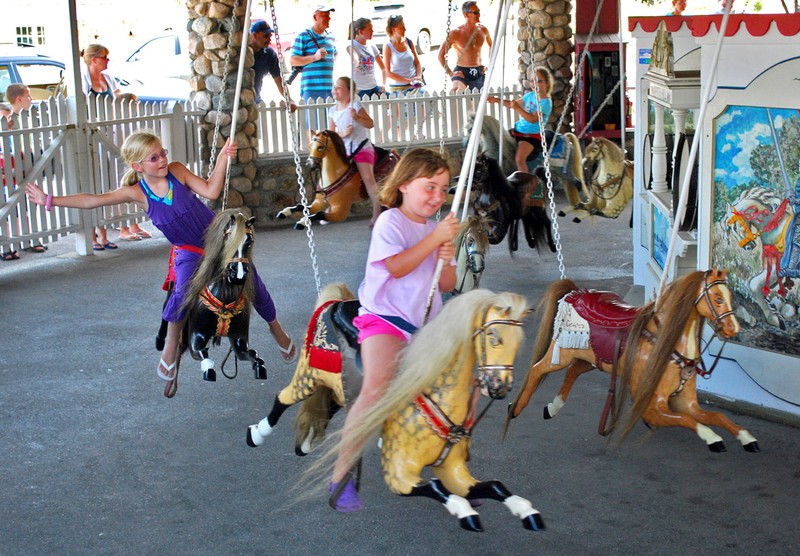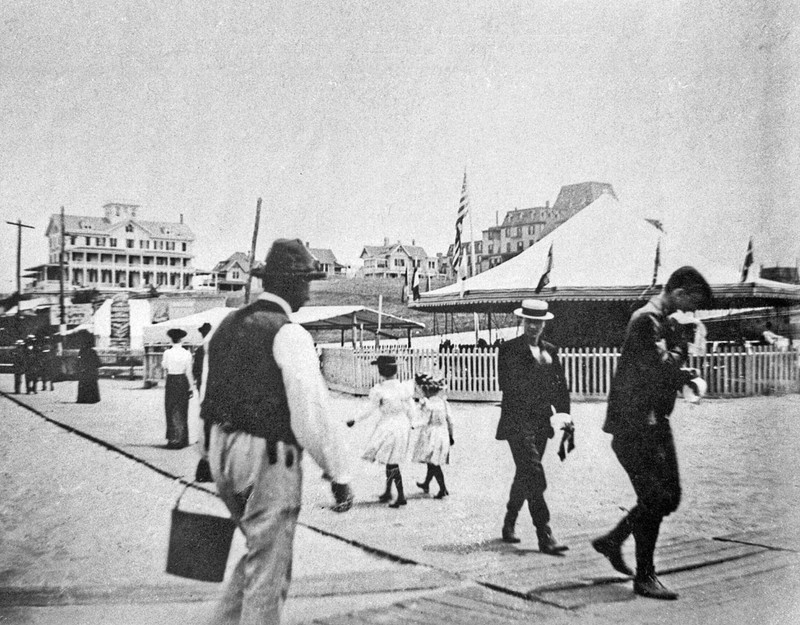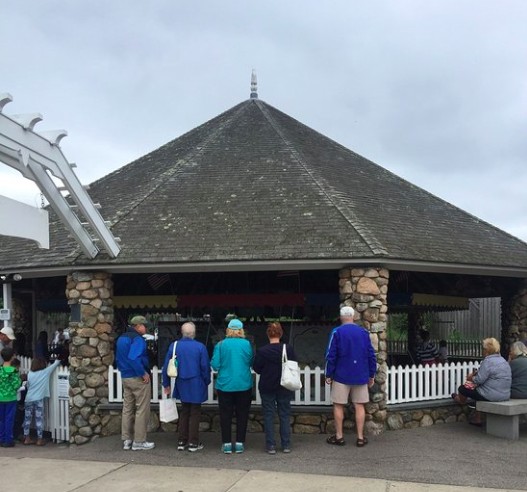Flying Horse Carousel
Introduction
Text-to-speech Audio
Images
Children riding modern version of Flying Horse Carousel

Circa 1900, features carousel's original canvas canopy

Modern photo of Flying Horse Carousel

Backstory and Context
Text-to-speech Audio
Thought to be constructed in 1867, but not officially recorded to be functioning until 1876, the Flying Horse Carousel in Westerly, Rhode Island still operates today and can be ridden by children ages twelve years and under from June through Labor Day. The carousel is thought to be the only remaining carousel in America in which the horses hang on chains from the roof of the structure, so that centrifugal force causes the horses to fly outwards as the carousel spins, inspiring the name “Flying Horse Carousel.” In a certain location on the outermost portion of the horses’ paths, there is a device which hangs down and contains small metal rings for children (on the outermost horses) to attempt to grab as they fly by. The final ring of the ride is a brass ring which, if grabbed by one of the children, grants that child a free ride on the carousel. In the early days of the carousel’s operation, children were given swords with which to reach for the rings as they passed by.
The carousel arrived in Watch Hill where it has since remained during one summer between 1879 and 1883 when it is thought that a travelling carnival left it behind for ultimately unknown reasons. While locals believe the carousel was constructed, by Andrew Christian and the Charles W. F. Dare Company of New York City, one of few prominent carousel-construction companies across the world and throughout history, in 1867, the exact date of its origins is disputed. Records show the carousel was functioning and open to the public, at least, by 1876, the same year of the alleged construction of another “Flying Horses Carousel” with similar origins in New York City, but which is presently located on Martha’s Vineyard in Oak Bluffs, Massachusetts. The carousel in Massachusetts is similarly constructed as the Flying Horse Carousel in Rhode Island and is one of few other remaining carousels which still feature the metal and brass ring concept. A crucial difference between the carousels is the Massachusetts carousel’s lack of a feature similar to the chained horses impacted by centrifugal force to create the “flying” feeling for imaginative and youthful riders as with the Rhode Island carousel.
This difference coupled with another key disparity between the structure of the carousel has convinced Rhode Islanders for decades that their carousel is the oldest in the nation rather than the Massachusetts carousel, and has even caused administrators from the Martha’s Vineyard Preservation Trust to concede that the horses on Watch Hill may predate those on Martha’s Vineyard, perhaps even with prototypical origins dating as far back as the early 1860s. The other crucial difference is in the construction and design of the horses on the carousels. The general artistic design and painting of the horses appears to reflect a more primitive and earlier example of the creators’ work. Additionally, restorations of the Rhode Island carousel during the 1990s led to the discovery that the construction and design of the horses, particularly their forelegs being parallel to the ground to give the appearance of flight, were likely inspired by a design pioneered by New York carver, Andrew Christian, in the early 1860s. It has since been believed by locals and those involved in the restoration efforts that the style of the horses was directly influenced during the 1860s (prior to the construction of the Massachusetts Flying Horses) by Christian, who ended up working with Charles Dare of Andrew Christian and the Charles W. F. Dare Company of New York City.
Initially, the carousel was powered manually by a horse with a rope tied to it from the center of the carousel, and the music was produced manually with a hand-cranked organ. In 1897, the carousel began to be powered by water and then electric in 1914. The original canopy was made of canvas while today it consists of asphalt shingles, and the floor beneath the horses used to be entirely sand while today it is concrete. In addition to the roughly twenty horses, the original carousel featured several chariots which were lost in one of countless environmental disasters which damaged the attraction. The chariots were never found after the New England Hurricane on September 21, 1938, which was very destructive for the whole Watch Hill village. The other horses were all found buried in nearby sand dunes and were subsequently restored and are the ones still in use today. The Flying Horse Carousel has since survived several more destructive environmental disasters including, most recently, Hurricane Sandy in 2012.
Sources
"Beneath the Paint: One Man's Trip Through an Old Carousel's Distant Past." New York Times. August 31, 1996. May 28, 2019. https://www.nytimes.com/1996/08/31/us/beneath-the-paint-one-man-s-trip-through-an-old-carousel-s-distant-past.html.
"Brass Rings, Ice Cream and Sea Breezes at Watch Hill Carousel in RI – Primitive Dare Swing Machine May Date Back as Early as 1867." The Carousel News & Trader. December, 2008.
Cawley, William A. The 1938 Hurricane, Westerly, Rhode Island, and Vicinity. Westerly, Rhode Island: Lewis R. Greene. 1938.
"Flying Horse Carousel." Trip Advisor. May 28, 2019. https://www.tripadvisor.com/Attraction_Review-g54122-d105989-Reviews-Flying_Horse_Carousel-Watch_Hill_Westerly_South_County_Rhode_Island.html.
"Flying Horse Carousel." Visit Rhode Island. May 28, 2019. https://www.visitrhodeisland.com/listing/flying-horse-carousel/407/.
"Flying Horse Carousel (Westerly)." National Park Service. November 23, 2010. May 28, 2019. https://web.archive.org/web/20101123172430/http://tps.cr.nps.gov/nhl/detail.cfm?ResourceId=1816&ResourceType=Building. National Historic Landmark summary listing.
Fried, Frederick. "Flying Horses of Martha's Vineyard Offer Surprise." Antique Monthly. July 1974. May 28, 2019.
Fried, Frederick. A Pictorial History of the Carousel. New York: Bonanza Books, 1964.
Libby, Steve. "Wooden Horses at Watch Hill." Worcester Sunday Telegram. August 15, 1976.
Moore, Harriet C. Around and Around, the Story of the Watch Hill Carousel. Westerly, Rhode Island: Sun Graphics, 1980.
Neblker, Walter. "Historic and Architectural Resources of Westerly, Rhode Island: A Preliminary Report." Rhode Island Historical Preservation Commission. Providence, Rhode Island, March 1978.
